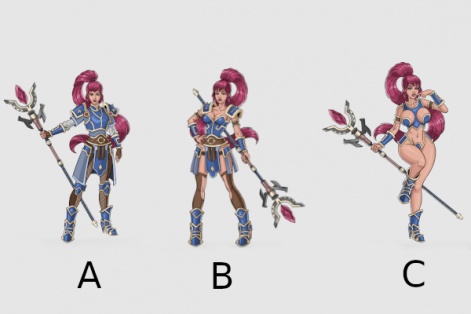Character design is a major part of any title, be it the protagonist or the NPCs which populate the world, but when it comes to creating these characters, what designs work best? Most gamers at some point will have come across a character that seemed overly sexualised,and in a recent survey from PickFu, 763 gamers took part in answering questions related to hyper-sexualisation in video games.
As part of the survey, each participant was given a character design that had three variations. The first option presented itself as the least sexualised with the character wearing full armour, a second design was slightly more sexualised, and a third which was overly sexualised. Those that took part in the survey were simply asked to pick the design they preferred.
Of the 763 respondents, 375 of them were female, 381 were male, and 7 identified as non-binary.

The results of the survey found that nearly two-thirds (65.3%) of the female participants rejected the most sexualised option and voted for option A, in comparison men who were slightly more varied in their choices with nearly half (48.8%) voting for option A. This means that men were three times more likely to vote for the overly sexualised design than female participants. 100% of those that identified as non-binary chose the least sexualised design, option A.
Those within the age brackets of 18-24, 55-64, and 65+ predominantly showed a dislike for the most sexualised option and were the most likely ages to vote for the least sexualised character. Gamers that opted for the most sexualised version tended to be male and to fall within the age bracket of between 25 and 54.
Education level was also highlighted in the survey, which appeared to have some influence on each person's preference. Two-thirds (66.7%) of respondents who held lower than high school qualifications voted for the most sexualised option. In comparison, those with degrees such as associate (21.7%), bachelor's (12.9%), and graduate degrees (3.6%) all voted far less frequently for the overly sexualised character design.
The results also highlighted that single respondents were nearly twice as likely to vote for the most sexualised option than those that were married.
What did respondents think?
Part of the survey allowed respondents to explain why they had picked a certain character.
One respondent who voted for the least sexualised option stated “I chose option A as my favourite because I like that she is wearing the most armour/protection. Someone who is going to be a fighter needs to be protected”
Another participant who voted for the option sitting in the middle said “Option B seems to nail the in-between of showing a beautiful female physique yet still offering a fantasy look with the costume”
As for the most sexualised option, a participant that opted for this choice said “All the character designs look good, but C gets my vote for being the most risqué and having the most attractive character.”
The majority of answers given by participants as to why they favoured a specific character or disliked another fell into the themes of sexualisation (where the participant made a direct link to the character's sexual features above all else), gaming skills (where the practicality of the character in the environment was mentioned) and finally personality traits (where respondents commented that the outfits reflected the personality of the character).
Overall, option A came out as the most popular choice amongst participants with 57% favouring that design, whilst option B settled at 37% and the most sexualised, option C, resulted in the fewest number of votes, counting for only 12%.
Another important factor alongside character design is narrative. We recently covered GameAnalytics examination of narrative design and how it can help create an immersive game.






















